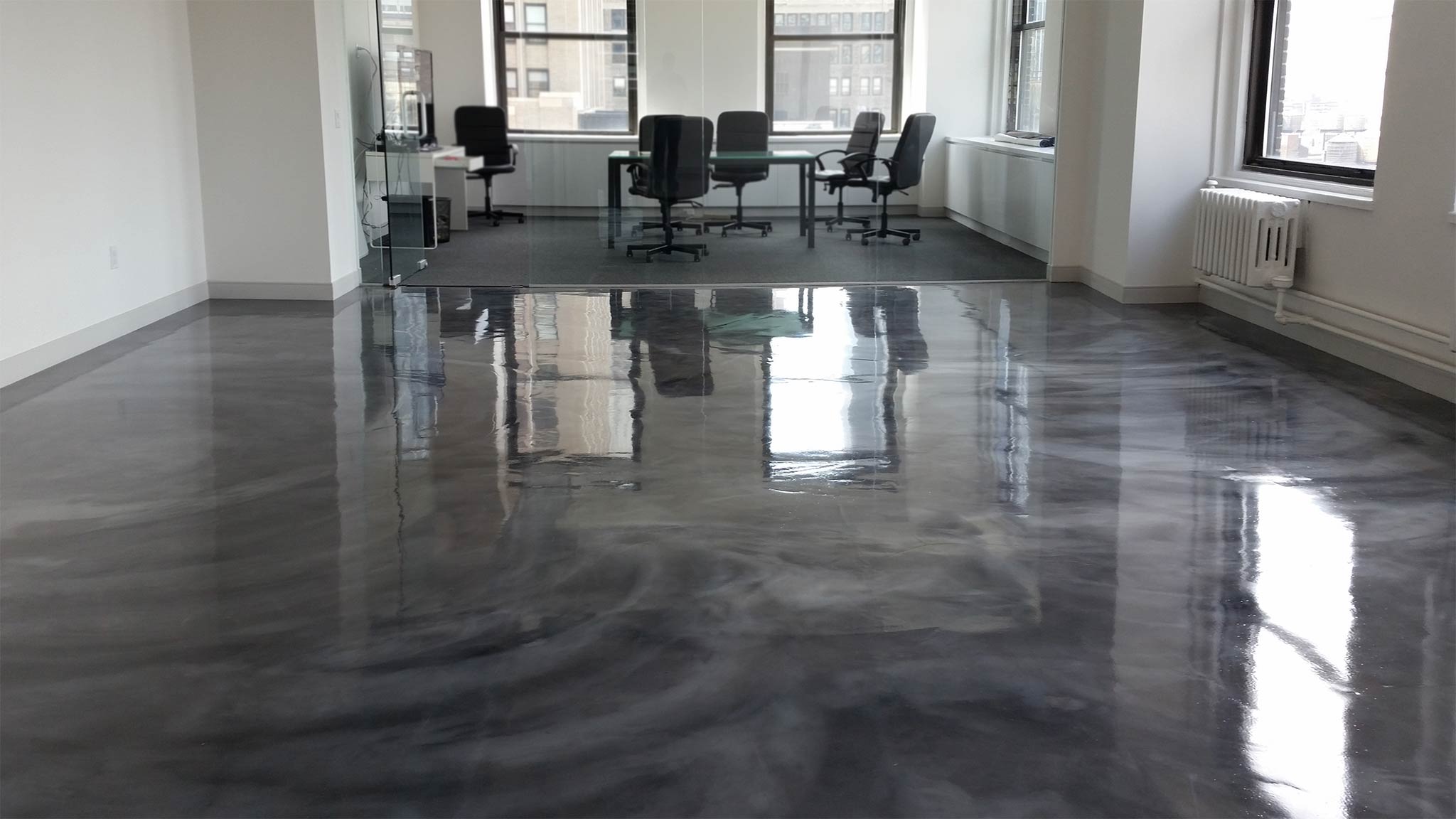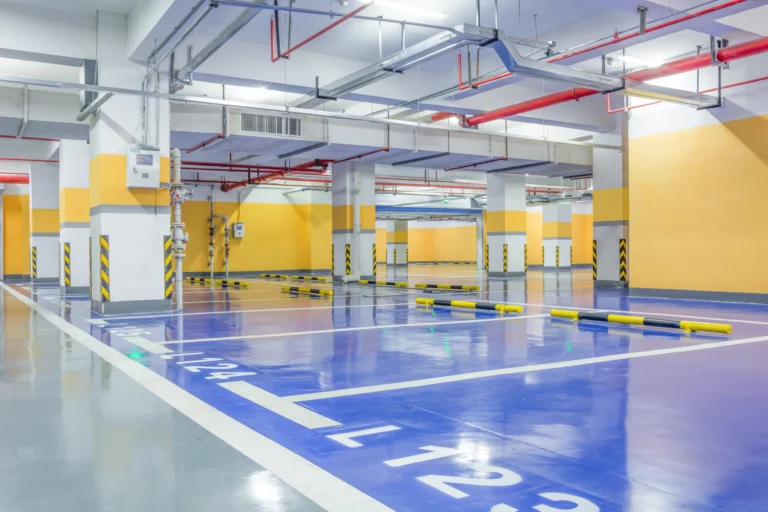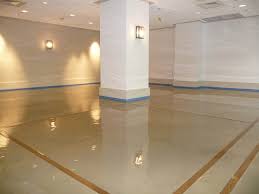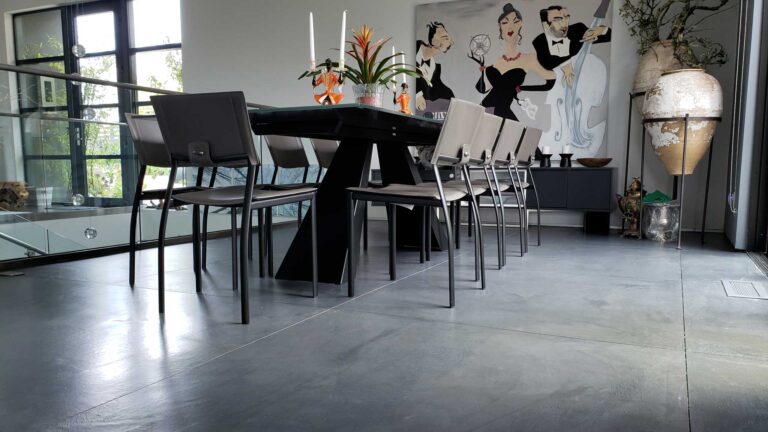Epoxy floors have become a popular choice for both residential and commercial spaces due to their durability and aesthetic appeal. This comprehensive guide will walk you through everything you need to know about epoxy flooring systems, from their benefits to installation processes, and how they compare to other flooring options.
Benefits of Epoxy Flooring Systems
Durability and Longevity
Epoxy floors are renowned for their exceptional durability. They can withstand heavy foot traffic, making them ideal for commercial and industrial settings. The longevity of epoxy flooring is another significant advantage, as it can last for decades without showing signs of wear and tear.
- Resistant to heavy impacts
- Long-lasting with minimal maintenance
- Ideal for high-traffic areas
Chemical and Stain Resistance
One of the standout features of epoxy floors is their resistance to chemicals and stains. This makes them a preferred choice for environments where spills and chemical exposure are common, such as laboratories and manufacturing plants.
- Protects against chemical spills
- Easy to clean and maintain
- Prevents staining from oils and other substances
Easy Maintenance and Cleaning
Epoxy floors are incredibly easy to maintain. Their seamless surface prevents dirt and debris from accumulating, making cleaning a breeze. Regular sweeping and occasional mopping are usually sufficient to keep them looking pristine.
- Seamless surface for easy cleaning
- Requires minimal maintenance
- Resistant to dust and dirt accumulation
Aesthetic Appeal and Customization Options
Epoxy flooring offers a wide range of aesthetic options, allowing for customization to suit any design preference. From vibrant colors to metallic finishes, epoxy floors can be tailored to enhance the visual appeal of any space.
- Available in various colors and finishes
- Can mimic the look of marble or granite
- Customizable with patterns and designs
Types of Epoxy Floor Coatings

Self-Leveling Epoxy
Self-leveling epoxy is designed to create a smooth, even surface over existing floors. It’s ideal for spaces that require a flawless finish, such as showrooms and retail stores.
- Provides a smooth, even finish
- Ideal for covering imperfections
- Suitable for commercial and residential use
Mortar Epoxy
Mortar epoxy is the most robust type of epoxy flooring, often used in industrial settings. It consists of a combination of epoxy resin and graded sand, providing a highly durable surface.
- Extremely durable and impact-resistant
- Suitable for industrial environments
- Can repair cracks and damage in existing floors
Graveled Epoxy
Graveled epoxy is known for its decorative appeal. It incorporates colored gravel or sand to create a textured, visually appealing surface, often used in commercial spaces.
- Offers a decorative, textured finish
- Customizable with various colors and patterns
- Ideal for commercial and retail spaces
Epoxy Flake Flooring
Epoxy flake flooring involves the addition of colored flakes to the epoxy mixture, creating a unique, speckled appearance. This type of flooring is popular in garages and recreational areas.
- Provides a unique, speckled look
- Enhances slip resistance
- Available in a variety of color combinations
Industries That Benefit from Epoxy Floors
Aviation and Aerospace
Epoxy floors are commonly used in aviation and aerospace industries due to their durability and resistance to chemicals. They provide a safe and clean environment for aircraft maintenance and operations.
- Durable and chemical-resistant
- Easy to clean and maintain
- Provides a safe working environment
Manufacturing and Automotive
In manufacturing and automotive industries, epoxy floors are favored for their ability to withstand heavy machinery and vehicle traffic. They also resist oil and chemical spills, making them ideal for these settings.
- Withstands heavy machinery and traffic
- Resistant to oil and chemical spills
- Provides a clean, professional appearance
Healthcare and Laboratories
Epoxy floors are a popular choice in healthcare and laboratory settings due to their seamless, easy-to-clean surface. They help maintain a sterile environment, essential for these industries.
- Seamless surface for easy cleaning
- Maintains a sterile environment
- Resistant to chemicals and stains
Food and Beverage Processing
In food and beverage processing facilities, epoxy floors are valued for their hygiene and safety features. They are resistant to spills and can be easily sanitized, ensuring compliance with health regulations.
- Hygienic and easy to sanitize
- Resistant to spills and stains
- Complies with health and safety regulations
Epoxy Floor Installation Process
Surface Preparation
Proper surface preparation is crucial for a successful epoxy floor installation. This involves cleaning and repairing the existing floor to ensure the epoxy adheres correctly.
- Clean and repair the existing floor
- Remove any debris or contaminants
- Ensure a smooth, even surface
Priming
Priming the floor is an essential step that enhances the adhesion of the epoxy coating. A primer is applied to the prepared surface, creating a strong bond between the floor and the epoxy.
- Enhances adhesion of the epoxy
- Creates a strong bond with the floor
- Prepares the surface for epoxy application
Epoxy Application
The epoxy is applied in multiple layers, depending on the desired thickness and finish. Each layer must be allowed to cure before applying the next, ensuring a durable and long-lasting floor.
- Apply multiple layers of epoxy
- Allow each layer to cure properly
- Achieve the desired thickness and finish
Curing and Finishing
After the final layer of epoxy is applied, the floor must be allowed to cure completely. This process can take several days, depending on the temperature and humidity levels.
- Allow the floor to cure completely
- Ensure optimal temperature and humidity
- Achieve a durable, long-lasting finish
Maintenance and Care for Epoxy Floors
Regular Cleaning Techniques
Regular cleaning is essential to maintain the appearance and longevity of epoxy floors. Simple techniques such as sweeping and mopping can keep the floor looking new.
- Sweep regularly to remove dust and debris
- Mop with a mild detergent for deeper cleaning
- Avoid using harsh chemicals or abrasive tools
Addressing Spills and Stains
Epoxy floors are resistant to most spills and stains, but it’s important to address them promptly to prevent any potential damage.
- Wipe up spills immediately
- Use a gentle cleaner for stubborn stains
- Avoid letting spills sit for extended periods
Periodic Resealing
To maintain the protective qualities of epoxy floors, periodic resealing may be necessary. This helps preserve the floor’s appearance and extends its lifespan.
- Reseal the floor every few years
- Protects against wear and tear
- Enhances the floor’s appearance
Epoxy Floors vs. Other Flooring Options
Comparison with Concrete Floors
Epoxy floors offer several advantages over traditional concrete floors. They provide a more durable and aesthetically pleasing surface, with added resistance to chemicals and stains.
- More durable than concrete
- Resistant to chemicals and stains
- Offers a polished, professional appearance
Advantages over Tile and Vinyl
Compared to tile and vinyl, epoxy floors offer superior durability and customization options. They are also easier to maintain and provide a seamless, modern look.
- Superior durability and longevity
- Customizable with various finishes
- Seamless, easy-to-clean surface
Customization Options for Epoxy Floors
Color Selection
Epoxy floors offer a wide range of color options, allowing for customization to match any design preference. From bold, vibrant colors to subtle, neutral tones, the possibilities are endless.
- Wide range of color options
- Customizable to match any design
- Enhances the visual appeal of any space
Metallic and Flake Additives
Metallic and flake additives can be incorporated into epoxy floors to create unique, eye-catching designs. These additives add depth and texture, enhancing the overall aesthetic of the floor.
- Create unique, eye-catching designs
- Add depth and texture to the floor
- Enhance the overall aesthetic appeal
Texture and Finish Choices
Epoxy floors can be customized with various textures and finishes, from smooth and glossy to textured and matte. This allows for further personalization to suit any style or preference.
- Various textures and finishes available
- Personalize to suit any style
- Enhance the floor’s functionality and appearance
Environmental Impact of Epoxy Floors
VOC Emissions
Epoxy floors can have varying levels of VOC (volatile organic compound) emissions, depending on the type of epoxy used. Low-VOC options are available, making epoxy flooring a more environmentally friendly choice.
- Low-VOC options available
- Reduces environmental impact
- Safer for indoor air quality
Sustainability Factors
Epoxy floors are a sustainable flooring option due to their durability and long lifespan. They require fewer resources for maintenance and replacement, reducing their overall environmental impact.
- Durable and long-lasting
- Requires fewer resources for maintenance
- Reduces overall environmental impact
Common Epoxy Floor Problems and Solutions
Bubbling and Peeling
Bubbling and peeling can occur if the epoxy is not applied correctly or if the surface is not properly prepared. Ensuring proper installation and surface preparation can prevent these issues.
- Ensure proper surface preparation
- Apply epoxy correctly
- Prevents bubbling and peeling
Discoloration
Discoloration can occur due to exposure to UV light or chemical spills. Using UV-resistant epoxy and addressing spills promptly can help prevent discoloration.
- Use UV-resistant epoxy
- Address spills promptly
- Prevents discoloration
Cracking and Chipping
Cracking and chipping can result from heavy impacts or improper installation. Ensuring proper installation and using high-quality materials can minimize the risk of cracking and chipping.
- Use high-quality materials
- Ensure proper installation
- Minimizes risk of cracking and chipping
Choosing the Right Epoxy Floor for Your Needs
Traffic Considerations
When choosing an epoxy floor, consider the level of foot and vehicle traffic the area will experience. High-traffic areas may require a more durable epoxy coating.
- Consider foot and vehicle traffic
- Choose a durable epoxy for high-traffic areas
- Ensures long-lasting performance
Chemical Exposure
Consider the level of chemical exposure the floor will face. Areas with frequent chemical spills may require a more resistant epoxy coating.
- Consider chemical exposure
- Choose a resistant epoxy for chemical-prone areas
- Ensures long-lasting protection
Aesthetic Requirements
Consider the desired aesthetic for the space. Epoxy floors offer a wide range of customization options to match any design preference.
- Consider desired aesthetic
- Choose from various customization options
- Enhances the visual appeal of the space
Epoxy Floor Trends and Innovations
New Formulations
New formulations of epoxy are continually being developed, offering improved durability, resistance, and aesthetic options. These innovations make epoxy flooring an increasingly popular choice for a variety of applications.
- Improved durability and resistance
- Enhanced aesthetic options
- Continual innovation in epoxy formulations
Advanced Application Techniques
Advanced application techniques are being developed to improve the installation process and the final result. These techniques ensure a smoother, more even finish and enhance the overall performance of the epoxy floor.
- Improved installation process
- Smoother, more even finish
- Enhanced performance of epoxy floors
Safety Considerations for Epoxy Floors
Slip Resistance
Ensuring slip resistance is a crucial safety consideration for epoxy floors. Adding texture or anti-slip additives can improve traction and reduce the risk of slips and falls.
- Add texture or anti-slip additives
- Improve traction and safety
- Reduce risk of slips and falls
Fire Resistance
Epoxy floors can offer fire-resistant properties, making them a safe choice for various applications. This can be particularly important in industrial and commercial settings.
- Fire-resistant properties
- Safe choice for various applications
- Important for industrial and commercial settings
Impact Resistance
Epoxy floors are highly impact-resistant, making them suitable for environments with heavy machinery or equipment. This ensures a durable, long-lasting surface that can withstand heavy use.
- Highly impact-resistant
- Suitable for heavy machinery and equipment
- Ensures a durable, long-lasting surface
FAQs
How soon can you walk on epoxy floors after installation?
You can typically walk on epoxy floors 24 to 48 hours after installation, depending on the temperature and humidity levels. It’s important to allow the floor to cure completely before subjecting it to heavy foot traffic or placing furniture on it. Proper curing ensures the durability and longevity of the epoxy floor.
Can epoxy floors be installed over existing flooring?
Epoxy floors can often be installed over existing flooring, provided the surface is properly prepared. This can save time and money by eliminating the need to remove the old flooring. Proper surface preparation is essential to ensure the epoxy adheres correctly and provides a durable, long-lasting finish.
Are epoxy floors slippery?
Epoxy floors can be slippery when wet, but there are ways to enhance their slip resistance. Adding texture or anti-slip additives can improve traction and reduce the risk of slips and falls. Proper installation and maintenance can also help ensure a safe, slip-resistant surface.
How long do epoxy floors last?
Epoxy floors are known for their longevity, often lasting 10 to 20 years or more with proper maintenance. The lifespan of an epoxy floor can vary depending on factors such as the quality of the installation, the level of foot traffic, and the type of epoxy used. Regular maintenance and care can significantly extend the life of an epoxy floor.
What is the average cost of epoxy flooring?
The average cost of epoxy flooring can vary depending on several factors, including the type of epoxy used, the size of the area, and the complexity of the installation. On average, epoxy flooring can cost between $3 to $12 per square foot. It’s important to consider the long-term benefits and durability of epoxy floors when evaluating the cost.





